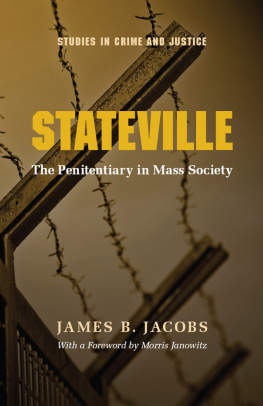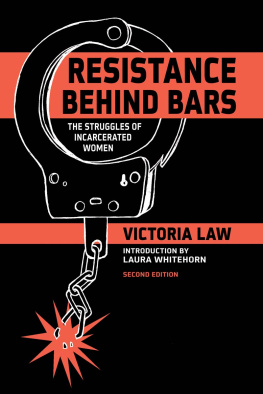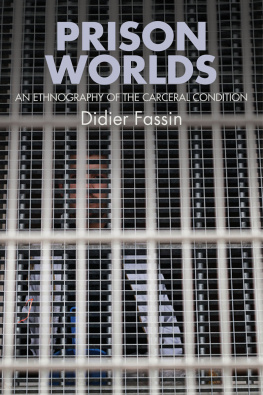The University of Chicago Press, Chicago 60637
The University of Chicago Press, Ltd., London
1977 by The University of Chicago
All rights reserved. Published 1977
Printed in the United States of America
18 17 16 15 14 13 12 11 10 09 8 9 10 11 12
ISBN: 978-0-226-21883-0 (ebook)
ISBN-13: 978-0-226-38977-6 (paper)
ISBN-10: 0-226-38977-4 (paper)
Library of Congress Cataloging-in-Publication Data
Jacobs, James B
Stateville.
(Studies in crime and justice)
Includes bibliographical references and index.
1. Illinois. State Penitentiary, Joliet. I. Title. II. Series.
HV9475.I32S824 365'.9773'25 76-22957
ISBN: 0-226-38977-4 (paper)
 The paper used in this publication meets the minimum requirements of the American National Standard for Information SciencesPermanence of Paper for Printed Library Materials, ANSI Z39.48-1992.
The paper used in this publication meets the minimum requirements of the American National Standard for Information SciencesPermanence of Paper for Printed Library Materials, ANSI Z39.48-1992.
Stateville
The Penitentiary in Mass Society
James B. Jacobs
THE UNIVERSITY OF CHICAGO PRESS
Chicago and London
STUDIES IN CRIME AND JUSTICE
Editorial Committee
Sanford H. Kadish
Norval Morris (Chairman)
James Vorenberg
Stanton Wheeler
Marvin E. Wolfgang
To My Mother and Father
Contents
by Morris Janowitz
Foreword
This is a historical and sociological study of a penitentiary; specifically, it presents fifty years of transformation and change of a large state prison. It is both a richly descriptive account and a powerfully trenchant analysis. The author has engaged in a careful historical examination of the archival records; he has pursued direct and prolonged participant observation with great skill; and, in addition, as a lawyer he has uniquely augmented his research by an elaborate assessment of the changing administrative and legal codes affecting the prison. Thus this book is a lasting contribution to the study of social institutions. But, in effect, it is also an analysis of contemporary society, since the prison and its internal life are a reflection of the state of the larger society. In the language of contemporary social science, this book is a contribution to macrosociology.
Sociologists have a rich tradition of exploring the social organization of the prison. The Chicago school of sociology was not limited to community studies; as in this case, it applied its perspective to a variety of institutions. Thus, this research builds on and enriches Donald Clemmers pioneering book The Prison Community, published in 1940. The literature on prisons contains some of the most outstanding research monographs in sociology; and let there be no misunderstanding: the vitality and the enduring core of sociology rest as much on its classic monographs as on its grand theories. For the individual sociologist, the prison is a manageable research site, one whose organization can be understood and mastered. At the same time, it is an encompassing and complex institution; it is an entity worthy of intensive research; to research a prison is to investigate a rather complete social system.
The intellectual power of this monograph results from James Jacobss ability to use the prison as an indicator of the social organization and moral values of the larger society. This is best done by examining the prison on a trend basis over time. The internal social stratification of the prison has reflected and continues to reflect the stratification system of the outside society. The conception of prison management and the organizational goals of the prison in turn are outgrowths of the struggles and accommodations of civil society.
Because he presents an overview of the various phases of the institutional life of the prison during a half-century, Jacobs is able to record both the internal changes and the transformation of the larger society. Stateville is not necessarily the typical prisonthere could be no single typical institution. But the trends in the history of Stateville are those which have operated throughout United States society. In the simplest terms, the prison has moved from an institution at the periphery of society, remote, isolated, with distinct boundaries, under the control of personalistic and authoritarian leadership. It was an organization with a strong emphasis on informal and interpersonal mechanisms of control. Over time, it has shifted more to the center of the larger society; its boundaries have become more permeable and its older control mechanisms have given way to more rational, bureaucratic, and legalistic arrangements.
Jacobs presents a developmental analysis in which a series of stages are identified that are common to social movement and institutional change. The old order of authoritarian control was followed by a period of mild reform, and mild reform only produced increased tension and hostility between prisoners and administration. The next phase was a more marked reform of the older systemwhich in turn produced more tension, disruption, and violence. In the pattern of the natural history of societal and institutional change, the subsequent phase was a counterreformationa search for and the emergence of a new format of greater stability and mutual, if uneasy, acceptance by the contending parties.
There can be no doubt that a dedicated band of reformers initiated the efforts at institutional change. Among those who were active before and immediately after World War II were academic sociologists and their students who entered prison administration. Their contributions were important, but they were without deep or lasting influence. The changing mood in the nationthe increased emphasis after 1945 on humanitarian goals and the strong belief in the potentials of rehabilitationserved to keep alive the goals of transforming the prison. However, the popular movements and the agitations of the 1960s set the process of institutional change in motion. These social and political movements served to politicize the prisoners and increase the tensions between inmate and administration.
A variety of external groups entered the prison and sought to participate in the decision-making process. James Jacobs highlights the penetration of the prison in the 1960s and 1970s by Black Muslims, by street gangs of the city of Chicago, and by civil liberty and legal groups, as well as by educational and social welfare agencies. These kept up the pressure for change and heightened the internal tensions. But the basis of real transformation came from the judicial review of prison administration and prison procedures. In the late 1960s the courts started to apply their definition of due process and equal protection to the lives of the inmates. They sought to extend to the prisoner essential aspects of the rights of citizenship.
The result was the emergence of a new set of legalistic and bureaucratic rules and procedures for guiding the day-to-day activities of the prison administrators and their staff. Under these conditions, it was understandable that unionization of the guards took place, since they were searching for a set of rules and procedures as well as an occupational ideology to defend their position in the prison system. Out of the legalistic emphasis, a new equilibrium emerged, accompanied by strong administrative control and by a decline or a constriction of tension and violence in the prison. The new equilibrium was based on important elements of the rule of law, but it was also based on a rejection of some administrative practices of the period of marked reform.
James Jacobs makes use of the notion of mass society to analyze and understand the transformation of the prison. The term mass society refers to societal movements which seek to incorporate each and every person into the political and legal systems of society. Mass society, as used by James Jacobs, draws on a specific formulation of the term; it does not focus only on increase in scale and complexity and on the growth of impersonality in an advanced industrial society. It is rather a concern with the efforts to create a moral and legal system appropriate for contemporary society. The concept emphasizes the extension of the rights of citizenship throughout the social structure. Jacobs, as a legal scholar, is aware that the rights of citizenshipthat is, particular elementsextend to the prison population as well. And the history of Stateville documents this transformation. A more legalistic, more bureaucratic prison system hardly creates a utopia, but it supplies a new basis for the social order of the prison.
Next page











 The paper used in this publication meets the minimum requirements of the American National Standard for Information SciencesPermanence of Paper for Printed Library Materials, ANSI Z39.48-1992.
The paper used in this publication meets the minimum requirements of the American National Standard for Information SciencesPermanence of Paper for Printed Library Materials, ANSI Z39.48-1992.